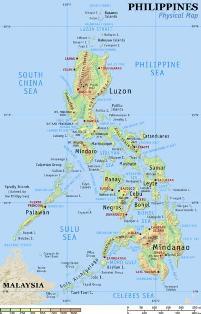|
Philippines Geography has more islands than you could possible visit.The Philippines geography is visually spectacular. It has 7,107 tropical sun drenched islands, of which more than 2,000 are uninhabited and 2,500 don’t even have a name. Typically the inland is mountainous which drop down to coastal plains and white sand beaches. It is nirvana for sun worshippers. Where are the Philippines?For those of you who do not know where the Philippines are, they are situated in South East Asia. West of the Philippines you will find Vietnam and has the South China Sea between them. The Luzon Strait separates the Philippines to the north with Taiwan and mainland China. To the east of the Philippine Islands you will come across the might of the Pacific Ocean, which batters the east coast and whips up some great surf. Depending on which part of the Philippines you leave and travel south from will determine which country you will bump into. So if you go south from Palawan Island, in the west of the Philippine Islands, you will come across Malaysia that is after you cross the Sulu Sea. Now if you go directly south from Mindanao you will travel over the Celebes Sea and arrive in Indonesia. Philippines Geography and the Islands………The total land area of the Philippines is roughly 300,000 square kilometers and out of the 7,107 islands of the Philippines, 11 islands make up 94% of the total landmass! So what does that mean? Well to me it means there are an awful lot of small islands just waiting for you to explore. Distances The distance east to west of the Philippine Islands is 1,127 kilometres. Philippines Geography – The terrainThe terrain of the Philippines has been brought about mostly due to volcanic activity. It is part of the Pacific Ring of Fire. So as you can imagine the islands are mountainous with short plains that run to the coast. There are about 22 active volcanoes in the Philippines and another 27 potentially active volcanoes. It also has more than double this amount as dormant volcanoes. The last eruption was quite devastating when Mt Pinatubo blew in 1991. Mt Pinatubo is on Luzon, she erupted on the 15th June 1991 and did not settle down for another three months. The explosion caused enormous devastation, 45,000 houses were totally destroyed, close to 250,000 people were left homeless and near to 1,000 deaths. The beaches in the area are now dark brown as a result of the huge amounts of ash that was dumped on the Zambales coastline. Today you can trek to the crater and view the lonely luna landscape. Philippine Rivers The Philippines geography has to include the river systems. There are 421 rivers in the Philippines with the most extensive being the Pulangi River or Rio Grande which flows into the Mindanao River, the Agusan River which is also on the island of Mindanao and empties into the Mindanao Sea. In the north of the Philippines on Luzon the longest river flows through the Central Cordilleras, the Cagayan River. Unfortunately fifty of the rivers in the Philippines are considered to be biologically dead, which is pretty sad. One of those is the Pasig River, which flows through Metro Manila and into Manila Bay, there are plans to clean it up but it will be a long process. The Philippines Geography is just perfect for the traveler who enjoys island hopping and exploring. There is always another island just waiting to be discovered, banca boats are always willing to take you wherever you choose. If you do not want to island hop then set yourself up in a hut on the beach or a five star resort, either way the geography in the Philippines is conducive to some serious relaxation. Philippines Climate
The climate in the Philippines is broken into two main seasons the Wet and Rainy and the Dry Season. In actual fact the seasons can vary quite a bit between the coastal plains and the inland mountains.
|
 If you are interested the Geographic Coordinates are 13 00 N, 122 00 E.
If you are interested the Geographic Coordinates are 13 00 N, 122 00 E.